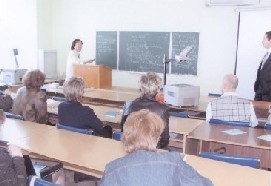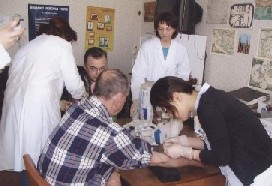Dispatch of Medical Professionals
Home > Dispatch of Medical Professionals > Dispatch List > Dispatched medical mission to Belarus
Dispatched medical mission to Belarus
Period:
Member of Mission:
Leader | Fumio Sawano | Director of the 5th Department of Medicine |
Member | Akiyoshi Tanioka | Administrative Director |
Member | Tadao Kajiwara | Chief Technician of Pathological Section |
Member | Kumiko Tanaka | Nurse |
| (4 above members from Hiroshima Red Cross Hospital & Atomic Bomb Survivors Hospital) | ||
Member | Hideo Yamada | Medical Interpreter |
Member | Kazuhiko Soyama | Secretary-General of The Japanese Red Cross Society Hiroshima Chapter |
Result of Medical Examination for the Radiation-exposed:

Scene of Medical Examination of thyroid gland in Brest Endocrine Institute
Medical examination of thyroid gland in Brest
Number of patients: 43 persons
Number of patients who had papillary adenocarcinoma: 6 persons
Medical examination of diabetes mellitus in Minsk
Number of patients undergone 75g oral glucose tolerance test: 20 persons
Medical Consultation and Lecture:

Lecture for medical graduate students in Minsk
Brest:
Idiopathic hypoparathyroidism
Type 1 diabetes mellitus
Minsk:
A case of prolonged hypoglycemia suspected as an insulinoma (discussed with the professors concerned)
Graves’ disease accompanied by type 2 diabetes mellitus
Lecture on the diagnosis of diabetes mellitus for graduate students of Minsk University Medical School at the 10th Minsk Hospital
Meeting about health care for the radiation-exposed:
Brest:
May 27, 2004 Meeting with the Governor of Brest County
Minsk:
May 24, 2004 Dr. Anton Romanovsky, Secretary General of the Belarusian Red Cross Republican Committee
June 1, 2004 Dr. Mudmila Postoyalko, Minister of Health of the Republic of Belarus
Impressions:
A campaign called“ Give a light on Chernobyl “ was started in 1991 under the joint auspices of the Asahi Shinbun newspaper office and the Japanese Red Cross Society. The first invitation for the radiation-exposed children was carried out then and continued for next several years.
In 1990, just one year before starting this campaign, I moved to Hiroshima Red Cross Hospital & Atomic Bomb Survivors Hospital as an endocrine specialist and began a new technique ( Aspiration Biopsy Cytology: ABC ) for the diagnosis of thyroid cancer which was already used by surgeons but not by internists at least in Hiroshima. So I could have an opportunity to examine these children using ultrasonic echogram and ABC besides the physical examination. Since then, medical doctors in USSR ( at present as Russia, Belarus and Ukraine ) involved in Chernobyl accident have been invited almost every year to my hospital and other medical organs concerned, providing the medical training to make a correct diagnosis of thyroid cancer and the other thyroid diseases. Also in 1997, by the request from Belarus, I had the second visit in Minsk to give the lectures on the thyroid diseases for the doctors engaged in medical examination tour there.
Because of these medical activities and other volunteer behaviors given by not only Japanese Red Cross Society but also other official or private supporting organizations, our party was welcomed with sincere appreciation by the people of Belarus themselves, not to mention the doctors actually concerned.
On this occasion, the medical delegation was dispatched with the assistance of the Hiroshima International Council for Health Care of the Radiation-Exposed ( HICARE ). At every meeting, Mr. Soyama made a speech on behalf of the Japanese Red Cross Society, Hiroshima Chapter, and I did on behalf of HICARE and my hospital respectively.
We stopped over at the Red Cross Nursing Home in Pinsk on our way to Brest. I was deeply impressed by the welcome ceremony, bread and salt at the entrance of the home, the patients living there, and the care providing by the nurses wearing in the traditional uniforms. The activities there reminded me of the basis of the Red Cross Spirit. They were truly quite touching.
Two co-medical staffs joined for the first time in this medical delegation. One of them, Mr. Kajiwara, Chief Technician of the Pathological Section of my hospital, tried and finally succeeded in staining the specimen by Papanicolaou’s method, which I had heard from our medical interpreter, Mr. Yamada, was difficult in Brest because of the lack of staining materials and some other reasons. This success made the doctors there, who had stained only by Giemsa’s method, very happy. Also as the most of the example figures in Atlas of Clinical Cytology which we presented to them for their reference are stained by Papanicolaou’s method, this fact will surely contribute in improving their diagnostic ability in the examination for thyroid diseases.
This time we made a final diagnosis during our stay in Brest, collaborating with Mr. Kajiwara. Obtained samples from the patients’ thyroid glands by aspiration biopsy, were immediately fixed and stained with both Papanicolaou’s and Giemsa’s solutions, respectively. Following the screening examination by Mr. Kajiwara, I made a final diagnosis with confirming his screening diagnosis and with my clinical findings, including the results from ultrasonic echogram. According to Dr. Yamada, no other visiting medical group had reached to the final diagnosis during their stay there and the local doctors took much delight in this event. I thank Mr.Kajiwara for his dedicated work and also need to thank Ms. Tanaka, nurse at our hospital, for her assistance during the aspiration procedures.
In Minsk, besides the examination for thyroid disease which we had spread continuously up to today, we newly tried to examine diabetes mellitus with 75g oral glucose tolerance test ( 75g OGTT ), this time. Expanding the extent of medical examination, we expect to promote deeper friendly relations in the field of health care. Since this examination had never taken place before, this was a bit of a challenge. But fortunately, with also the aid of Ms. Tanaka, we could have obtained the results that twenty persons were undergone 75g OGTT. As I made the question about patients’ condition rather precisely with Dr. Yamada’s translational help, I hope that I will be able to take a glance of the tendency or the character of Belarusian people. The doctors in charge told us that these medical examinations were very curious and would be quite helpful for them.
In addition, it was my great honor that I was consulted directly by the relatives of the patient and could have had several discussions with doctors concerned about several endocrine or metabolic cases which were difficult to make a final diagnosis or to define the adequate treatment.
Lastly, I would like to express my sincere appreciation to Mr. Tanioka, Administrative Director of our hospital, for his excellent work as treasurer, and to my friend, Dr. Yamada for his fluent Russian which is always greatly helpful for our activities.
Written by Fumio Sawano, M.D., Ph.D.
Director of the 5th Department of Medicine
(Endocrine-Metabolic Disease Section)
Hiroshima Red Cross Hospital & Atomic Bomb Survivors Hospital

Mr. Kajiwara's trial for Papanicolaou’s staining

Ms.Tanaka's activity



